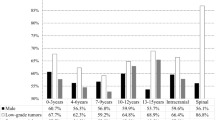Abstract.
Method: The topography, sex distribution and histology of 340 primary CNS tumors in children up to 17 years of age were investigated and (re-)classified according to the latest WHO classification of nervous system tumors. Results: Overall the prevalence for boys (60.9%) was higher and supratentorial locations predominated (53.3%); there was an even distribution of low-grade WHO I/II (51.5%) and high-grade WHO III/IV (48.5%) tumors. Boys were more commonly affected in all age groups throughout childhood and adolescence. Infratentorial location was more common between the ages of 3 and 11 years (57.5%). High-grade tumors were more frequently encountered up to the age of 5 years (53.2%). The main histological entities were pilocytic astrocytomas (23.5%), followed by medulloblastomas (16.3%), ependymomas (10.1%), anaplastic astrocytomas and glioblastomas (7.2% each), and craniopharyngiomas (5.6%); astrocytomas overall accounted for 47.3% of pediatric brain tumors. Rarer entities included germ cell tumors, gangliogliomas, and meningiomas (2.5% each), supratentorial PNET and pineal parenchymal tumors (1.9% each), atypical teratoid/rhabdoid tumors (1.3%), choroid plexus tumors (0.9%), and desmoplastic infantile astrocytomas and dysembryoplastic neuroepithelial tumors (0.6% each). A meta-analysis of 10,582 childhood brain tumors accumulated from 16 international surveys revealed a male-female ratio of 1.29 and a supra-/infratentorial ratio of 0.92. The most common histological diagnoses were astrocytomas (37.6%), medulloblastomas (17.7%), ependymomas (9.9%), craniopharyngiomas (7.3%), and germ cell tumors (4.4%). Conclusions: Pediatric brain tumors vary considerably in their histological, topographical and gender distribution throughout childhood and adolescence, reflecting different dynamics of individual tumor entities as well as a susceptibility to their occurrence during certain periods of a child’s life. Although at times difficult to characterize, pediatric CNS tumors can be satisfactorily classified according to the latest WHO classification of nervous system tumors.
Similar content being viewed by others
Author information
Authors and Affiliations
Additional information
Electronic Publication
Rights and permissions
About this article
Cite this article
Rickert, C.H., Paulus, W. Epidemiology of central nervous system tumors in childhood and adolescence based on the new WHO classification. Child’s Nerv Syst 17, 503–511 (2001). https://doi.org/10.1007/s003810100496
Received:
Published:
Issue Date:
DOI: https://doi.org/10.1007/s003810100496




